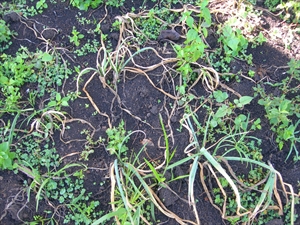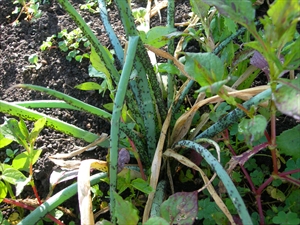Onion aphid
Pacific Pests, Pathogens, Weeds & Pesticides - Online edition
Pacific Pests, Pathogens, Weeds & Pesticides
Onion aphid (276)
Neotoxoptera formosana. Two other species, Neotoxoptera violae (violet aphid) and Neotoxoptera olieri (marigold aphid) are closely related.
Asia, Africa (St. Helena), North and South America, Europe (restricted), Oceania. It is recorded from Australia, New Zealand, and the highlands of Papua New Guinea. It was first recorded in Taiwan, but now occurs widely in the tropics and sub-tropics.
Members of the onion (Allium) family, including chives, leeks, onion, shallot, leeks, and weed relatives of onion.
The aphid lives on onions and their relatives, either on the leaves (Photo 1) or on the bulbs in storage. Populations increase rapidly to damaging levels and plants wilt, yellow, collapse, and dry (Photo 2).
Eggs are unknown, and so are males. Females give birth to living young without fertilization. The nymphs pass through four stages before they become winged or wingless adults. The body length is 1.5-2.5 mm, and the antennae are approximately the same length as the body. Adults are dark red to black. Winged individuals occur occasionally, and they have distinctive wide black veins.
It is thought that this aphid is attracted to the compounds in Allium species that give them their distinctive smell.
Spread over short distances occurs by adults walking between plants, and over long distances on air currents, and on bulbs traded on domestic or international markets. Survival occurs on volunteer plants from the previous crop or on bulbs in storage.
Damage occurs in two ways: directly as the aphids suck the sap of plants causing them to collapse, and indirectly through the spread of viruses. The latter are reported in Japan. The extent of either kind of damage is not well documented, but the fact that populations increase quickly and cause the collapse of plants suggests that it can be considerable. Serious rots in storage are reported from Australia.
Look for dark red or black aphids, mostly wingless, but some winged with broad veins on the wings.
NATURAL ENEMIES
Predators [ladybird beetles and their larvae, hover (syrphid) flies and lacewing larvae], and parasites (wasps) usually keep onion aphid populations low; however, the rapid population increase of the onion aphid may mean that the smell of onions, and other Allium species, keeps natural enemies away.
CULTURAL CONTROL
Before planting:
- Do not plant down-wind from crops with aphids. Occasionally, winged aphids are produced or wingless ones are spread in strong winds onto new crops.
- Establish plants that are favoured by hoverflies whose syrphid larvae eat aphids; for instance, plant oregano, buckwheat, alyssum, bachelor buttons, and dill.
During growth:
- Remove weeds from within and also outside the crop, especially any that are in the onion family.
- Inspect crops often and regularly; destroy leaves heavily infested with aphids by hand (or if necessary use insecticides - see below).
- Mulch the crop. Plastic mulches, clear or black, may delay build-up of aphids as they find it difficult to distinguish crops growing in them.
After harvest:
- Collect, burn or bury the remains of the crop after harvest. Do not leave any parts of the crop that can regrow.
CHEMICAL CONTROL
If ants are present, find the nest, and if not too close to the plants with aphids, destroy the nest with boiling water; alternatively, use ant baits or spray with synthetic pyrethroids.Without ants, predators and parasites will bring about natural control.
If insecticides are necessary against aphids, use any of the following:
- Use soap solution, horticultural oil (made from petroleum), or white oil (made from vegetable oils) as follows (see Fact Sheet no. 56):
- White oil:
- 3 tablespoons (1/3 cup) cooking oil in 4 litres water
- 1/2 teaspoon pure hand soap, not detergent
- Shake well and use.
- Soap:
- Use soap (pure soap, not detergent):
- 5 tablespoons of soap in 4 litres water.
- White oil:
- Commercial horticultural oil can also be used. These sprays work by blocking the breathing holes of insects causing suffocation and death. Spray the underside of leaves, as the soap and oils must contact the aphids.
Alternatively, use:
- Plant-derived products, such as neem, derris, pyrethrum and chilli (with the addition of soap). (See Fact Sheet no. 56).
- Rosemary oil has been shown to repel onion aphids; test it to see if it is effective.
- Synthetic pyrethroids are likely to be effective against aphids, and also ants, but will also kill natural enemies.
--------------------
Note, derris (Derris species) contains rotenone, an insecticide, often used as a fish poison; it should be used with caution. The commercial derris insecticide is made from Derris elliptica.
____________________
When using a pesticide, (even a biopesticide) always wear protective clothing and follow the instructions on the product label, such as dosage, timing of application, and pre-harvest interval. Recommendations will vary with the crop and system of cultivation. Expert advice on the most appropriate pesticide to use should always be sought from local agricultural authorities.
AUTHOR Grahame Jackson
Information from Neotoxoptera formosana Onion aphid. InfluenialPoints.com. (https://influentialpoints.com/Gallery/Neotoxoptera_formosana_onion_aphid.htm); and from Neotoxoptera formosana (NEOTFO) (2021) EPPO Global Database. (https://gd.eppo.int/taxon/NEOTFO/documents).
Produced with support from the Australian Centre for International Agricultural Research under project PC/2010/090: Strengthening integrated crop management research in the Pacific Islands in support of sustainable intensification of high-value crop production, implemented by the University of Queensland and the Secretariat of the Pacific Community.





